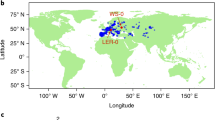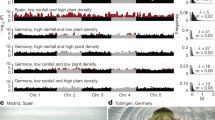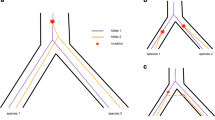Abstract
Arabidopsis has become a model plant for ecological and population genomics, owing to the substantial phenotypic and genotypic variation that exists among and within natural populations. Specially, the recent availability of large worldwide collections of accessions, together with their full genome sequences, has triggered the study of Arabidopsis natural variation. In this chapter, we describe two protocols that exploit these new resources to understand the natural variation for any trait and gene: (1) the phenotypic analysis of Arabidopsis plants grown in field experiments; (2) the analysis of nucleotide diversity and environmental associations for specific genes.
Access this chapter
Tax calculation will be finalised at checkout
Purchases are for personal use only
Similar content being viewed by others
References
Somerville C, Koornneef M (2002) A fortunate choice: the history of Arabidopsis as a model plant. Nat Rev Genet 3:883–889
Bergelson J, Roux F (2010) Towards identifying genes underlying ecologically relevant traits in Arabidopsis thaliana. Nat Rev Genet 11:867–879
Weigel D, Nordborg M (2015) Population genomics for understanding adaptation in wild plant species. Annu Rev Genet 49:315–338
Kramer U (2015) Planting molecular functions in an ecological context with Arabidopsis thaliana. elife 4:e06100
Takou M, Wieters B, Kopriva S et al (2019) Linking genes with ecological strategies in Arabidopsis thaliana. J Exp Bot 70:1141–1151
Hoffman MH (2002) Biogeography of Arabidopsis thaliana (L.) Heynh. (Brassicaceae). J Biogeogr 29:125–134
Brennan AC, Mendez-Vigo B, Haddioui A et al (2014) The genetic structure of Arabidopsis thaliana in the South-Western Mediterranean range reveals a shared history between North Africa and southern Europe. BMC Plant Biol 14:17
Kasulin L, Rowan BA, Leon RJC et al (2017) A single haplotype hyposensitive to light and requiring strong vernalization dominates Arabidopsis thaliana populations in Patagonia, Argentina. Mol Ecol 26:3389–3404
Mandáková T, Thorbjörnsson H, Pisupati R et al (2017) Icelandic accession of Arabidopsis thaliana confirmed with cytogenetic markers and its origin inferred from whole-genome sequencing. Icel Agric Sci 30:29–38
Exposito-Alonso M, Becker C, Schuenemann VJ et al (2018) The rate and potential relevance of new mutations in a colonizing plant lineage. PLoS Genet 14(2):e1007155
Alonso-Blanco C, Koornneef M, van Ooijen JW (2006) QTL analysis. In: Salinas J, Sanchez-Serrano JJ (eds) Arabidopsis protocols, 2nd edn. Humana Press, Totowa
Wijnen CL, Keurentjes JJ (2014) Genetic resources for quantitative trait analysis: novelty and efficiency in design from an Arabidopsis perspective. Curr Opin Plant Biol 18:103–109
Bazakos C, Hanemian M, Trontin C et al (2017) New strategies and tools in quantitative genetics: how to go from the phenotype to the genotype. Annu Rev Plant Biol 68:435–455
Alonso-Blanco C, Aarts MG, Bentsink L et al (2009) What has natural variation taught us about plant development, physiology, and adaptation? Plant Cell 21:1877–1896
Alonso-Blanco C, Mendez-Vigo B (2014) Genetic architecture of naturally occurring quantitative traits in plants: an updated synthesis. Curr Opin Plant Biol 18:37–43
Martin A, Orgogozo V (2013) The loci of repeated evolution: a catalog of genetic hotspots of phenotypic variation. Evolution 67:1235–1250
Barboza L, Effgen S, Alonso-Blanco C et al (2013) Arabidopsis semidwarfs evolved from independent mutations in GA20ox1, ortholog to green revolution dwarf alleles in rice and barley. Proc Natl Acad Sci U S A 110:15818–15823
Durvasula A, Fulgione A, Gutaker RM et al (2017) African genomes illuminate the early history and transition to selfing in Arabidopsis thaliana. Proc Natl Acad Sci U S A 114:5213–5218
Fulgione A, Koornneef M, Roux F et al (2017) Madeiran Arabidopsis thaliana reveals ancient long-range colonization and clarifies demography in Eurasia. Mol Biol Evol 35:564–574
Zou YP, Hou XH, Wu Q et al (2017) Adaptation of Arabidopsis thaliana to the Yangtze River basin. Genome Biol 18:239
Hsu CW, Lo CY, Lee CR (2019) On the postglacial spread of human commensal Arabidopsis thaliana: journey to the East. New Phytol 222:1447–1457
1001 Genomes Consortium Group (2016) 1,135 genomes reveal the global pattern of polymorphism in Arabidopsis thaliana. Cell 166:481–491
Lee CR, Svardal H, Farlow A et al (2017) On the post-glacial spread of human commensal Arabidopsis thaliana. Nat Commun 8:14458
Wilczek AM, Roe JL, Knapp MC et al (2009) Effects of genetic perturbation on seasonal life history plasticity. Science 323:930–934
Chiang GC, Barua D, Dittmar E et al (2013) Pleiotropy in the wild: the dormancy gene DOG1 exerts cascading control on life cycles. Evolution 67:883–893
Kerdaffrec E, Filiault DL, Korte A et al (2016) Multiple alleles at a single locus control seed dormancy in Swedish Arabidopsis. elife 5:e22502
Kerwin RE, Feusier J, Muok A et al (2017) Epistasis x environment interactions among Arabidopsis thaliana glucosinolate genes impact complex traits and fitness in the field. New Phytol 215:1249–1263
Malmberg RL, Held S, Waits A et al (2005) Epistasis for fitness-related quantitative traits in Arabidopsis thaliana grown in the field and in the greenhouse. Genetics 171:2013–2027
Brachi B, Faure N, Horton M et al (2010) Linkage and association mapping of Arabidopsis thaliana flowering time in nature. PLoS Genet 6:e1000940
Oakley CG, Agren J, Atchison RA et al (2014) QTL mapping of freezing tolerance: links to fitness and adaptive trade-offs. Mol Ecol 23:4304–4315
Postma FM, Agren J (2016) Early life stages contribute strongly to local adaptation in Arabidopsis thaliana. Proc Natl Acad Sci U S A 113:7590–7595
Price N, Moyers BT, Lopez L et al (2018) Combining population genomics and fitness QTLs to identify the genetics of local adaptation in Arabidopsis thaliana. Proc Natl Acad Sci U S A 115:5028–5033
Hepworth J, Antoniou-Kourounioti RL, Bloomer RH et al (2018) Absence of warmth permits epigenetic memory of winter in Arabidopsis. Nat Commun 9:639
Fournier-Level A, Korte A, Cooper MD et al (2011) A map of local adaptation in Arabidopsis thaliana. Science 334:86–89
Mendez-Vigo B, Gomaa NH, Alonso-Blanco C et al (2013) Among- and within-population variation in flowering time of Iberian Arabidopsis thaliana estimated in field and glasshouse conditions. New Phytol 197:1332–1343
Wilczek AM, Cooper MD, Korves TM et al (2014) Lagging adaptation to warming climate in Arabidopsis thaliana. Proc Natl Acad Sci U S A 111:7906–7913
Hu J, Lei L, de Meaux J (2017) Temporal fitness fluctuations in experimental Arabidopsis thaliana populations. PLoS One 12:e0178990
Taylor MA, Cooper MD, Sellamuthu R et al (2017) Interacting effects of genetic variation for seed dormancy and flowering time on phenology, life history, and fitness of experimental Arabidopsis thaliana populations over multiple generations in the field. New Phytol 216:291–302
Exposito-Alonso M, Brennan AC, Alonso-Blanco C et al (2018) Spatio-temporal variation in fitness responses to contrasting environments in Arabidopsis thaliana. Evolution 72:157–1586
Frachon L, Libourel C, Villoutreix R et al (2017) Intermediate degrees of synergistic pleiotropy drive adaptive evolution in ecological time. Nat Ecol Evol 1:1551–1561
Gomez R, Mendez-Vigo B, Marcer A et al (2018) Quantifying temporal change in plant population attributes: insights from a resurrection approach. AoB Plants 10:ply063
Kawakatsu T, Huang SC, Jupe F et al (2016) Epigenomic diversity in a global collection of Arabidopsis thaliana accessions. Cell 166:492–505
Togninalli M, Seren U, Meng D et al (2017) The AraGWAS catalog: a curated and standardized Arabidopsis thaliana GWAS catalog. Nucleic Acids Res 46:D1150–D1156
Seren U, Vilhjalmsson BJ, Horton MW et al (2012) GWAPP: a web application for genome-wide association mapping in Arabidopsis. Plant Cell 24:4793–4805
Grimm DG, Roqueiro D, Salome PA et al (2017) easyGWAS: a cloud-based platform for comparing the results of genome-wide association studies. Plant Cell 29:5–19
Seren U, Grimm D, Fitz J, Weigel D, Nordborg M, Borgwardt K, Korte A (2017) AraPheno: a public database for Arabidopsis thaliana phenotypes. Nucleic Acids Res 45:D1054–D1059
Bradbury PJ, Zhang Z, Kroon DE et al (2007) TASSEL: software for association mapping of complex traits in diverse samples. Bioinformatics 23:2633–2635
Rozas J, Ferrer-Mata A, Sanchez-DelBarrio JC et al (2017) DnaSP 6: DNA sequence polymorphism analysis of large data sets. Mol Biol Evol 34:3299–3302
Kumar S, Stecher G, Li M et al (2018) MEGA X: molecular evolutionary genetics analysis across computing platforms. Mol Biol Evol 35:1547–1549
Leigh J, Bryant D (2015) PopART: full-feature software for haplotype network construction. Methods Ecol Evol 6:1110–1116
Goodstein DM, Shu S, Howson R et al (2012) Phytozome: a comparative platform for green plant genomics. Nucleic Acids Res 40:D1178–D1186
Madeira F, Park YM, Lee J et al (2019) The EMBL-EBI search and sequence analysis tools APIs in 2019. Nucleic Acids Res 47:W636–W641. https://doi.org/10.1093/nar/gkz268
Nicholas KB, Nicholas HBJ, Deerfield DW (1997) GeneDoc: analysis and visualization of genetic variation. EMBNETWNEWS 4:1–4
Wang Y, Lu J, Yu J et al (2013) An integrative variant analysis pipeline for accurate genotype/haplotype inference in population NGS data. Genome Res 23:833–842
Danecek P, Auton A, Abecasis G et al (2011) The variant call format and VCFtools. Bioinformatics 27:2156–2158
Ferrero-Serrano A, Assmann SM (2019) Phenotypic and genome-wide association with the local environment of Arabidopsis. Nat Ecol Evol 3:274–285
Frichot E, Schoville SD, Bouchard G et al (2013) Testing for associations between loci and environmental gradients using latent factor mixed models. Mol Biol Evol 30:1687–1699
Gunther T, Coop G (2013) Robust identification of local adaptation from allele frequencies. Genetics 195:205–220
Rangel TF, Diniz-Filho JAF, Bini LM (2010) SAM: a comprehensive application for spatial analysis in macroecology. Ecography 33:46–50
Nordborg M, Hu TT, Ishino Y et al (2005) The pattern of polymorphism in Arabidopsis thaliana. PLoS Biol 3:e196
Clewer AG, Scarisbrick DH (2008) Practical statistics and experimental design for plant and crop science. John Wiley & Sons Ltd, West Sussex
Picó FX (2012) Demographic fate of Arabidopsis thaliana cohorts of autumn- and spring-germinated plants along an altitudinal gradient. J Ecol 100:1009–1018
Duncan S, Holm S, Questa J et al (2015) Seasonal shift in timing of vernalization as an adaptation to extreme winter. elife 4:e06620
Donohue K (2009) Completing the cycle: maternal effects as the missing link in plant life histories. Philos Trans R Soc B 364:1059–1074
Alonso-Blanco C, Blankestijn-de Vries H, Hanhart CJ et al (1999) Natural allelic variation at seed size loci in relation to other life history traits of Arabidopsis thaliana. Proc Natl Acad Sci U S A 96:4710–4717
Busoms S, Paajanen P, Marburger S et al (2018) Fluctuating selection on migrant adaptive sodium transporter alleles in coastal Arabidopsis thaliana. Proc Natl Acad Sci U S A 115:E12443–E12452
Exposito-Alonso M, Vasseur F, Ding W et al (2018) Genomic basis and evolutionary potential for extreme drought adaptation in Arabidopsis thaliana. Nat Ecol Evol 2:352–358
Postma FM, Agren J (2018) Among-year variation in selection during early life stages and the genetic basis of fitness in Arabidopsis thaliana. Mol Ecol 27:2498–2511
Gomaa NH, Montesinos-Navarro A, Alonso-Blanco C et al (2011) Temporal variation in genetic diversity and effective population size of Mediterranean and subalpine Arabidopsis thaliana populations. Mol Ecol 20:3540–3554
Paradis E, Claude J, Strimmer K (2004) APE: analyses of phylogenetics and evolution in R language. Bioinformatics 20:289–290
Kuittinen H, Salguero D, Aguade M (2002) Parallel patterns of sequence variation within and between populations at three loci of Arabidopsis thaliana. Mol Biol Evol 19:2030–2034
Manzano-Piedras E, Marcer A, Alonso-Blanco C et al (2014) Deciphering the adjustment between environment and life history in annuals: lessons from a geographically-explicit approach in Arabidopsis thaliana. PLoS One 9(2):e87836
Sokal RR, Oden NL (1978) Spatial autocorrelation in biology 1. Methodology. Biol J Linn Soc 10:199–228
Manel S, Joost S, Epperson BK et al (2010) Perspectives on the use of landscape genetics to detect genetic adaptive variation in the field. Mol Ecol 19:3760–3772
Tabas-Madrid D, Mendez-Vigo B, Arteaga N et al (2018) Genome-wide signatures of flowering adaptation to climate temperature: regional analyses in a highly diverse native range of Arabidopsis thaliana. Plant Cell Environ 41:1806–1820
François O, Martins H, Caye K et al (2016) Controlling false discoveries in genome scans for selection. Mol Ecol 25:454–469
Acknowledgements
C.A.-B. and F.X.P. laboratories have been funded by grants BIO2016-75754-P and CGL2016-77720-P (AEI/FEDER, UE), respectively.
Author information
Authors and Affiliations
Corresponding author
Editor information
Editors and Affiliations
Rights and permissions
Copyright information
© 2021 Springer Science+Business Media, LLC, part of Springer Nature
About this protocol
Cite this protocol
Alonso-Blanco, C., Méndez-Vigo, B., Xavier Picó, F. (2021). Analyses of Natural Variation: Field Experiments and Nucleotide Diversity for Your Favorite Gene. In: Sanchez-Serrano, J.J., Salinas, J. (eds) Arabidopsis Protocols . Methods in Molecular Biology, vol 2200. Humana, New York, NY. https://doi.org/10.1007/978-1-0716-0880-7_3
Download citation
DOI: https://doi.org/10.1007/978-1-0716-0880-7_3
Published:
Publisher Name: Humana, New York, NY
Print ISBN: 978-1-0716-0879-1
Online ISBN: 978-1-0716-0880-7
eBook Packages: Springer Protocols




